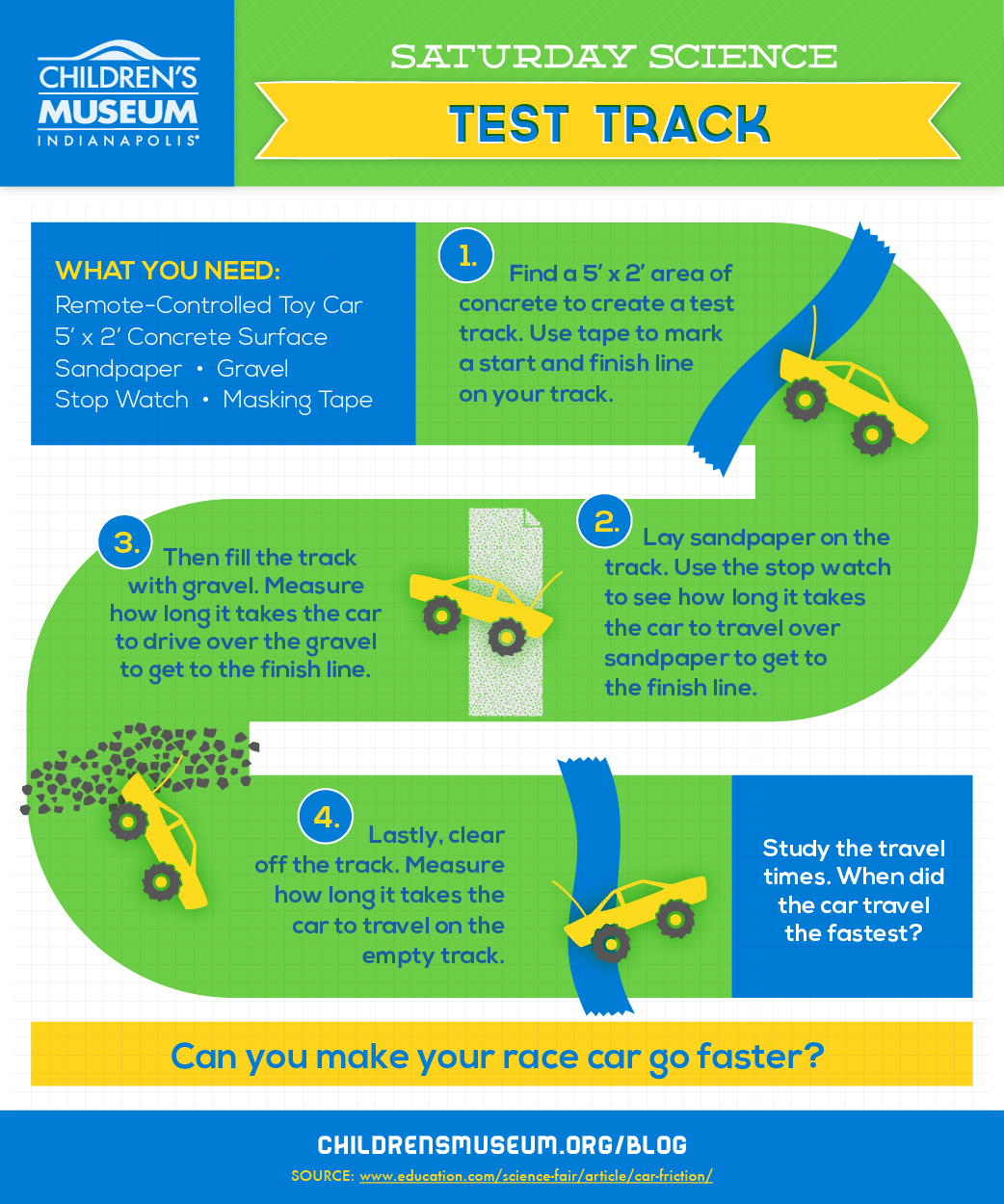
Whether you're anxiously awaiting this year's running of the Indianapolis 500 or visiting our Racing Experience, the racing excitement is real in Indy this May! Rev up your engines for this week’s Saturday Science, where we'll discover which surface will make a toy car go faster. Try it with a remote-controlled car, or a Hot Wheels car!
3 … 2 … 1 … the green flag means GO!
Try it with a remote-controlled car!...
Materials:
- Remote-controlled toy car (or small toy car)
- Sandpaper
- Gravel (or pea gravel if using a small toy car)
- Concrete (or other hard, flat and dry surface)
- Pencil
- Notebook
- Measuring tape
- Stopwatch
- Masking tape
- Parent or friend
Process:
- Build your race track! Use your measuring tape to measure out a track that is at least five feet long and two feet wide. The track can be indoor or outdoor, but it needs to be on an area that is hard, flat and dry.
- Make your start and finish line! Stick pieces of tape at the beginning and end of your track.
- Race your car! Lay sandpaper down on the track and place your toy car at the starting line. Have a parent or friend time your car with a stopwatch. Use the remote control to race your car to the finish line. When your car crosses the finish line, your parents or friend should stop the stopwatch. Record that time in your notebook.
- Now remove the sandpaper and fill the track with gravel (or pea gravel). Repeat step three.
- Now clear the track and repeat step three.
- Study your race times.
Try it with a Hot Wheels car!...
Materials:
- Hot Wheels Cars
- At least 24 inches of Hot Wheels track
- Strips of materials with different surfaces—sand paper, foam, aluminum foil
- Stop watch (or use the clock on your phone.)
Process:
- Have your child complete a control test, which means you are not changing the surface of the track. Place a car at the top of the track and work together to time the car as it runs down the track.
- Set up the track or ramp so it's at an angle. At least 24 inches of track will be needed.
- Choose a material and predict if the car will move faster or slower as the surface changes. Cut the material so it fits inside the track, for the entire length.
- Time the car as it runs down the track. Good scientific procedure is to complete more than one test of each surface.
- Test multiple surfaces, and brainstorm other materials to add that will either speed up or slow down the car.
- Ask your family, why did some of tracks go faster or slower? Why do with think the speed changed?
- To demonstrate the heat can be generate when friction is present, have your child rub their hands together to feel the heat.
Results:
Other than a car's engine and horsepower, its speed is determined by the friction between its wheels and the road.
On which track did your car drive the fastest? Rub your finger on each surface. Which one is the smoothest? Which ones make it more difficult to keep your finger moving forward? This friction between your finger and each surface is the same friction that happened between your car’s wheels and each surface. When you drove your car on the clear track, its wheels were met with little resistance. That allowed your car to be faster than it was on the tracks with the sandpaper and gravel. This also explains why the oval at the Indianapolis Motor Speedway is a smooth surface. On race day, all 33 drivers are hoping to drive their Indy cars as fast as they can!
Friction is caused mainly by rough surfaces. When the particles on each surface rub against each other they take the energy from the moving object. The particles get excited and therefore heat up. That is what causes the heat between your hands when you rub them together. Friction essentially converts moving energy into heat. Without friction objects could continue to move forever without stopping. Friction can be the downfall of our energy problems but it also helps a lot. Friction allows us to use the brakes in our cars. We wouldn’t even be able to walk if friction did not exist.
Can't get enough race car action? Visit the Riley Children's Health Sports Legends Experience® and put your top speeds to the test at our Racing Experience. Challenge your family to a race around our track and visit the pagoda to learn more about the Indianapolis 500. We'll see you at the Winner's Circle!

 (
(










